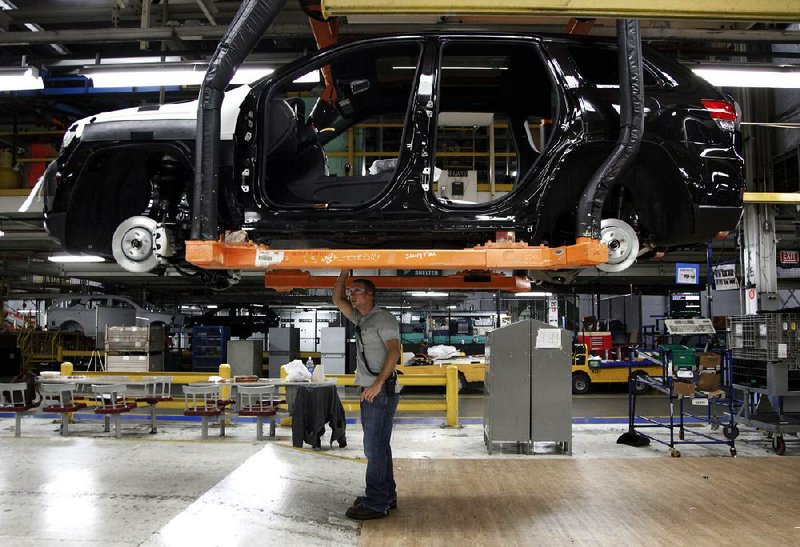The U.S. economy expanded by more than estimated in the second quarter, the Commerce Department reported Thursday, providing evidence to economists that growth is picking up as the nation overcomes the effects of federal tax increases and budget cuts.
Gross domestic product rose at a 2.5 percent annualized rate, up from an initial estimate of 1.7 percent. The median forecast of 79 economists surveyed by Bloomberg projected a 2.2 percent gain.
The improvement in growth shows the world’s largest economy gaining momentum after a drought, superstorm Sandy and budget battles in Washington stalled growth in the last three months of 2012. Recent data have shown the labor market is gaining strength while home prices rise, bolstering household finances.
“The economy is doing fine,” said Brian Jones, a senior U.S. economist at Societe Generale in New York, who correctly projected the gain in GDP. “It is going to weather the sequestration. Growth will accelerate in the second half.”
Automatic across-the board federal spending cuts are known as sequestration.
Stocks advanced, sending the Standard & Poor’s 500 index higher for a second day. The gauge climbed 0.2 percent to 1,638.17 at the close in New York.
Estimates for U.S. GDP, the value of all goods and services produced, ranged from gains of 0.3 percent to 2.5 percent, based on forecasts from economists surveyed by Bloomberg.
RELATED ARTICLE
http://www.arkansas…">Jobless claims for week fall 6,000, stay near 5-year low
Thursday’s revision paints a clearer picture of an economy gaining momentum. The second quarter’s growth rate followed gains of 0.1 percent in the fourth quarter and 1.1 percent in the first three months of this year.
Economists expect growth will stay at an annual rate of about 2.5 percent in the second half of the year, helped by steady job gains and less drag from federal spending cuts.Still, some say higher interest rates might restrain the economy’s expansion in the second half.
Rates could rise even further if the Federal Reserve decides to reduce its $85 billion a month in bond purchases at its September meeting. The Fed will consider the stronger second-quarter growth when making a decision next month. The bond purchases have helped keep long-term borrowing rates low.
Paul Ashworth, chief U.S. economist at Capital Economics, said stronger growth in the second quarter “should give Fed officials more confidence that the recovery is gathering steam as the fiscal drag begins to fade.”
He said the Fed is now more likely to slow the bond purchases in September, although that decision depends heavily on the August employment report. The government will release the employment report next week.
Thursday’s report said consumer spending climbed 1.8 percent, the same as previously reported, propelled by gains in durable goods such as automobiles and appliances. That came after a 2.3 percent increase from January through March. Purchases added 1.2 percentage points to growth.
Consumers’ purchasing power improved, with disposable income adjusted for inflation rising at a 3.2 percent annualized rate from April through June after a 7.9 percent decrease in the first quarter. The saving rate in that period increased to 4.5 percent from 4.1 percent.
Thursday’s report also included revisions to first-quarter personal income. Wages and salaries fell by $46.2 billion, revised up by $10.7 billion from the previously reported $56.9 billion drop. They climbed by $55 billion in the second quarter.
The GDP report also offered a first look at corporate profits. Before-tax earnings rose at a 3.9 percent rate, the biggest gain since the fourth quarter of 2011, after falling at a 1.3 percent pace in the prior period.
Gross domestic income, which reflects all the money earned by consumers, businesses and government agencies, climbed at a 2.5 percent annualized rate in the second quarter, matching the gain in GDP.
The trade deficit in the second quarter was smaller than previously estimated, reflecting the biggest gain in exports in more than two years. The gap was little changed from the first quarter, eliminating the 0.8 percentage-point drag previously estimated.
On the business side, corporate spending grew at a 9.9 percent annualized rate, exceeding the 9 percent gain previously reported. This reflected a $62.6 billion gain in stockpiles that was larger than first estimated. Smaller gains in outlays for equipment and intellectual property were offset by bigger increases in commercial construction.
Government spending fell at a 0.9 percent annualized rate, compared with a prior estimate of a 0.4 percent decline, as state and local outlays dropped.
Thursday’s report also showed price pressures remained contained. A measure of inflation, which is tied to consumer spending and strips out food and energy costs, rose at a 0.8 percent annualized pace. It was the weakest performance since the fourth quarter of 2010.
The lingering effect of fiscal tightening is forecast to wane this quarter and the next. The payroll tax had reverted to its 2010 rate of 6.2 percent in January after holding at 4.2 percent for two years, resulting in lower take-home pay.
Information for this article was contributed by Shobhana Chandra, Lorraine Woellert, Jeanna Smialek and Chris Middleton of Bloomberg News and by Martin Crutsinger of The Associated Press.
Front Section, Pages 1 on 08/30/2013

